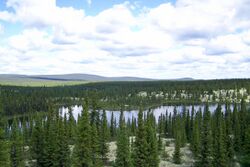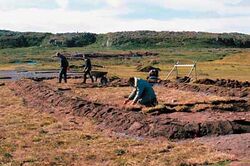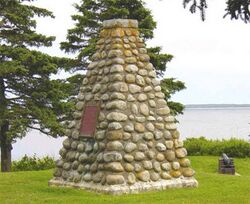Terre-Belle
This article is incomplete because it is pending further input from participants, or it is a work-in-progress by one author. Please comment on this article's talk page to share your input, comments and questions. Note: To contribute to this article, you may need to seek help from the author(s) of this page. |
Terre-Belle | |
|---|---|
Province | |
| Motto(s): Regnat populus (Solarian) "The people rule" | |
 Map of Cassier with Terre-Belle in red | |
| Country | |
| Capital (and largest city) | Port-Calme |
| Largest metro | Port-Calme metropolitan area |
| Confederation | 1 July, 1757 |
| Government | |
| • Premier | [name] |
| • Governor | [name] |
| • Legislature | Provincial Assembly of Terre-Belle |
| Area | |
| • Land | 2,278,492.16 km2 (879,730.74 sq mi) |
| • Rank | 1st |
| Population (2018) | |
| • Total | 519,685 |
| • Rank | 8th |
| • Density | 0.23/km2 (0.6/sq mi) |
| Time zone | UTC+7 to +8 (Florian/Vehemens) |
| Abbreviation | TB |
| Prefix | A, B |
| ISO 3166 code | CA-TB |
| Rankings include all provinces and territories | |
Terre-Belle is the westernmost province in Cassier. It comprises the islands of Terre-Belle, Île d’Édouard, and several thousand other smaller islands. As of 2018 Terre-Belle had 518,685 inhabitants, making it the least populated province in Cassier, accounting for only 1.3 percent of Cassier's total population. The majority of its population reside in or within the surrounding metropolitan area of Port-Calme, which is both the province's capital and largest city. With a geographical area of 2,278,492.16 square kilometres, Terre-Belle is the largest province in terms of geographical area, accounting for roughly 24 percent of Cassier's land area. The province's capital and largest city is Port-Calme.
Terre-Belle is entirely surrounded by water and has no land borders with any other province or territory. Gaullicans make up the majority of Terre-Belle’s population, however minorities such as Ghailles and indigenous groups such as the Megsig and Borealians also have a noticeable presence in the province.
The recorded history of Terre-Belle began in 1489 following the arrival of explorer Assim Asteris on Île d’Édouard. His arrival brought an end to the isolation of the indigenous Asterians and the beginning of Euclean colonization of the New World. Ghaillish mariners established small seasonal outposts in the late 15th century, though they were largely abandoned by the mid-16th century. Gaullican explorer Rogerin Dumont bestowed Terre-Belle its name in 1534 following his difficult voyage across the Vehemens Ocean to Asteria Superior, claiming the land for Gaullica. For most of its history, Terre-Belle was administered by the colonial government of Terre-Belle and the Dumont Bay Company, which controlled much of northern Cassier until its incorporation in 1870. Terre-Belle was one of the colonies to confederate into the Domain of Cassier on July 1, 1757, along with Chicadia, New Sylvagne, Upper Cassier, and Lower Cassier. It remained a part of Cassier until 1915, when Terre-Belle voted to return to direct Gaullican rule. As a consequence, it was directly involved in the events of the Great War, having an active role in contrast to Cassier’s neutrality during the conflict. Following Gaullica’s defeat, Terre-Belle was briefly occupied by Rizealand and other Grand Alliance forces until Cassier’s declaration of independence on October 14, 1936.
Etymology
Geography
The province of Terre-Belle comprises the namesake island of Terre-Belle, Île d’Édouard to the east, as well as several thousand islands. The island of Terre-Belle itself is the largest non-continental island in Kylaris, separated from the rest of Asteria Superior by Dumont Bay and the Gulf of Chicadia.
There are three major mountain systems in the province; Violet, Occidental, and Imperial ranges. The Violet Range; located in the south easternmost portion of Terre-Belle; is the northernmost section of the Charbagne Mountains and maintains the rolling and eroded characteristics of those seen on the Cassien mainland. The Occidental Range are the westernmost mountains in the Asterias, whose proximity to the Vehemens and Florian Oceans combined with the influence of glaciation has produced fjords and deep valleys. The Imperial Range, located along Terre-Belle’s north coast, are largest range of mountains in the province and are dominated by the presence of ice fields and glaciers.
Terre-Belle is also characterized by large, relatively flat regions. In the northern interior is a large basin of depressed land created by the weight of large ice sheets during the last ice age. This basin is host to thousands of lakes and rivers that ultimately drain into Dumont Bay. In the centremost area of the province is also a vast plateau which is also the site of many large lakes and rivers.
Climate
The climate of Terre-Belle is divided among three different zones. The largest, making up a majority of Terre-Belle’s land, is the subarctic zone. The areas within this zone experience cold, snowy winters and short, cool summers that rarely exceed 20°C, similarily to other subarctic areas found elsewhere in Cassier. The next largest zone is the arctic zone, located in the northernmost regions of the province or on the summits of tall mountain peaks. Areas in this zone experience long and very cold winters and short, cool summers. Encompassing the southernmost portion of Terre-Belle and Île d’Édouard is the temperate zone which is characterized by oceanic and continental climates. This zone’s location in lower latitudes and its proximity to warmer ocean water gives this region a milder climate compared to those of the other two climate zones on the island.
Ecology
With the exception of the arctic zone, Terre-Belle's landscape is dominated by large areas of forest and woodland. Taiga and boreal forests, dominated by coniferous trees and other hardy plants, make up the majority of vegetation in the province. Mixed or broadleaf forests are limited to the temperate zone in the south, where more moderate temperatures can support a higher diversity of plant species.
During the last ice age the island of Terre-Belle was completely covered by glaciers and swept clean of life, resulting in very few species that can be considered "native". Similarly, only freshwater-fish capable of surviving seawater swam to the island. The island is home to only several dozen mammal species, with no snakes, raccoons, skunks or porcupines. Terre-Belle is host to an array of plant species' such as Long’s braya (Braya longii) and Fernald’s braya (B. fernaldii), which are unique to the island. Recently, several plants and animals have been introduced to Terre-Belle. Moose, snowshoe hare, Asterian red squirrel, and others, were brought to the island through specific wildlife mandates or by accident.
History
Early history
The first human inhabitants in the province of Terre-Belle were hunter-gatherers who are believed to have arrived between 11,000 to 8,500 years ago from the Cassien mainland. Known as the Ársa cultures, these cultures were similar to their mainland counterparts, residing the coastline and subsisting via fishing or the hunting of sea mammals. Archeological findings have revealed that the Ársa cultures were capable mariners, conducting long-distance voyages and reaching as far south as New Sylvagne. The Ársa cultures thrived from about 7000 to 1500 BCE until gradually disappearing following the arrivial of the Ivoire culture around 2000 BCE. Similarly to the Ársa, the Ivoire culture was also highly maritime and quickly spread throughout Terre-Belle. Archeological findings of artifacts made of bone and ivory, as well as the remains of kayaks and boats, have revealed that the Ivoire culture came to dominate Terre-Belle between 1500 BCE to 850 CE.
The following and most recent cultures of peoples who first migrated to Terre-Belle were !Algic and Borealian peoples. The Algic peoples arrived from the mainland between 100 BCE to 50 CE, and unlike the Ivoire or earlier Ársa cultures, were not so wholely reliant on the sea, hunting and trapping game and practicing agriculture. The first Borealians are believed to have migrated to Terre-Belle from what is now northern Montagne beginning around 1300 CE. Researchers believe that both the !Algic peoples and the Borealians possessed several technological advantages over the Ivoire culture, allowing them to outcompete the Ivoire culture who would rapidly dissappear in the following century.
Terre-Belle's population steadily rose following the arrival of !Algic and Borealian groups to Terre-Belle. Archeological findings of arrow heads and spears indicates that tribal warfare between the various chieftanships and bands on Terre-Belle was frequent, particularly in the southern resource-rich portions of the island. The practice of routine migration throughout the year was widespread, with groups hunting sea mammals and fishing during the summer and then moving inland to hunt large game during the winter. Similarly to what was seen on the mainland, the peoples of southern Terre-Belle and Île d’Édouard divided territory between numerous organized political entities which overseen by tribal councils and chieftans.
Euclean discovery
There has been a great deal of fascination and speculation regarding the possiblity of Terre-Belle's discovery by Old World explorers before the arrival Assim Asteris. The most popular theory originates from legends of the voyages Saint Brendan of Caldia, a Ghaillish monk who was said to have journied to an eastern land across the Vehemens Ocean during the Marauder Age, which is often believed to be Terre-Belle. While modern experiments have shown that pre-Assimian crossings to Terre-Belle are possible, a lack of any firm evidence has resulted in the majority of historians and archeologists rejecting these claims.
In 1489, Assim Asteris would make landfall on what is now widely believed to be Île d’Édouard, representing the first undisputed discovery of the Asterias by an Old World explorer. Claiming the land for the Crown of Caldia, Asteris continued to explore the western coast of Cassier and Rizealand before making the return voyage to Euclea. Eager to capitalize on Asteris' discovery, Caldia sought to solidify their claims over what was named "New Caldia". Caldia established the first Euclean settlement in Cassier at Fort St. Elmo in 1492, which was followed by numerous small, seasonal havens utilized by mariners and traders during the late 15th and early 16th centuries. Despite being the first Euclean nation in the region, Caldian colonization efforts in New Caldia were limited in success. By the time Gaullican explorer Rogerin Dumont's arrived in the region in 1534, Terre-Belle had largely been abandoned by Ghaillish settlers who had migrated to the more hospitible colonies on the mainland or further south.
In a bid to challenge Caldia's claims in Asteria Superior, Gaullica dispatched Rogerin Dumont to Asteria Superior in 1534. Dumont explored much of what is now western Cassier and Terre-Belle during his voyages, opening up Terre-Belle for Gaullican colonization efforts.
Colonial and dominion eras
(1535 - 1915)
- The Colony of Terre-Belle was officially established in 1610 with the founding of Port-Calme. - Primarly based around export of fur, fish, and timber. - Largely isolated and viewed as a far fringe of the Gaullican Empire, Terre-Belle remains the least populated colony of New Gaullica. - The Dumont Bay Company is charted in 1670 and is granted large swaths of northern Terre-Belle. Île d’Édouard is transfered from the Colony of Chicadia as compensation. - Terre-Belle sends representitives to the Verlois Conference and agrees to join the Domain of Cassier as a province in 1757. - Not much happens during the Asterian War of Seccession, aside from small raids and battles in the Barrier Islands. - Terre-Belle experiences stable population and economic growth during the domain era, but continues to lag behind the rest of Cassier. The provincial government attempts to remedy this through infastructure and various schemes, accruing massive debts in the process. - Terre-Belle gets slammed by the Great Collapse so badly that it votes to leave the Domain of Cassier and return to direct Gaullican control in 1915.
Seperation from Cassier and the Great War
(1915 - 1939)
- An appointed council of Gaullican and local administrators enact reforms in Terre-Belle to begin mitigating the effects of the Great Collapse to some degree of success. - Large deposits of metals are discovered by prospectors, resulting in an economic boom. - Following Rafael Duclerque's takeover of the Gaullican, these administrators are replaced with functionalist-party members who seek to turn Terre-Belle into a "model colony". The new government quickly gets to work overhauling Terre-Belle's infastructure, economy, and defensive positions, while implimenting harsh policies against non-Gaullican minorities and dissidents, many of whom flee to Rizealand or Cassier. - Terre-Belle had an active role during the Great War, unlike the mainland which had a more passive role during the conflict. It is subject to frequent bombing campaigns by the Great Alliance, before being invaded in 1931 by Rizealand, alongside other Great Alliance members and Cassien volunteers. The island is placed under Rizean occupation for the duration of the war as a "liberated" territory. - Following Gaullica's surrender, Rizealand continues to occupy Terre-Belle until a popular referedum results in its reunion with Cassier in 1939. Rizealand is granted basing rights alongside other economic priviledges in the province.
Modern period
(1939 - present)
- Cassier begins an ardious process of reintegration and rooting out the remnants of functionalism in Terre-Belle. This proves tedious and allows many functionalists and party members to escape. - Terre-Belle regains its status as a province in 1948. - Federal support and economic development in the 1950s leads to economic and population growth in the province. - Disputes over fishing rights in the Vehemens leads to tensions with Euclean nations, culminating in international arbitration and an extention to Cassier's EEZ. - Depleted fish stocks and a federal ban on commercial whaling results serious economic damage and unemployment in Terre-Belle, while enviromental concerns begin put serious restrictions over mining and resource exploration. This move proved politically divisive, resulting in Terre-Belle becoming a "battle ground" province in future elections. - The first Indigenous People's Party member wins a seat representing the Northern Lakes district of Terre-Belle in the Chamber of Representatives in the 1986 general election. - Fishing stocks began to recover in the 2000s, while federal restrictions over mining are loosened following the discovery of large metal deposits. The province heavily invests in renewable sources of electricty such as wind and hydro, alongside tourism and the tech industries.
Demographics
The province of Terre-Belle has a total of 519,685 inhabitants according to the 2018 Cassien Census accounting for only 1.3 percent of the national total, making it the least populous province in Cassier. At 0.23 persons per square kilometre, Terre-Belle is also the least densely populated of Cassier's provinces. The majority of the population live in the southernmost portions of the island of Terre-Belle or on Île d’Édouard, where the milder oceanic and continental climates are more accomidating for agriculture and habitation. Terre-Belle's population is urbanized, with 62 percent of its population living in centres with populations greater than 6 thousand inhabitants. With a population of 108 thousand people, its capital city of Port-Calme is province's largest city, and the only one with a population exceeding 30 thousand inhabitants.
The province is linguistically dominated Gaullican speakers, with 76.0% of residents reporting Gaullican as their mother tongue as of the 2018 census. Additionally, Terre-Belle is home to the largest concentration of Ghaillish speakers in Cassier, with 28,536 inhabitants identifying Ghaillish as either their primary or secondary language. !Algic and Borealian languages are also spoken, predominately within various small indigenous communities spread throughout the islands.
| Largest urban centers by population | |||||||
|---|---|---|---|---|---|---|---|
| Rank | Town | Population (2018) | |||||
| 1 | Port-Calme | 108,000 | |||||
| 2 | Tebouque | 27,000 | |||||
| 3 | Saint-Pierre | 24,000 | |||||
| 4 | Saint-Esprit | 21,000 | |||||
| 5 | Dierre | 20,000 | |||||
| 6 | Port-Dubois | 17,000 | |||||
| 7 | Le Passage | 13,000 | |||||
| 8 | Pointe de l'Est | 11,000 | |||||
| 9 | Jeanville | 11,000 | |||||
| 10 | Valmoyen | 10,000 | |||||



